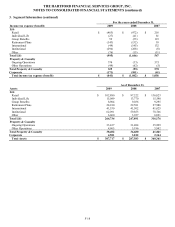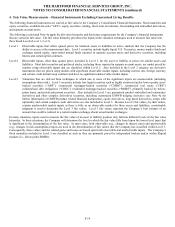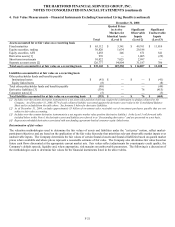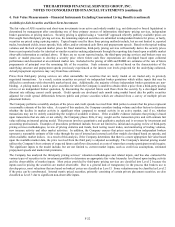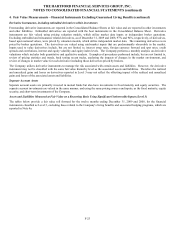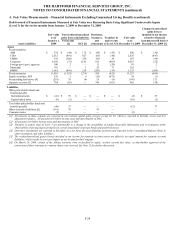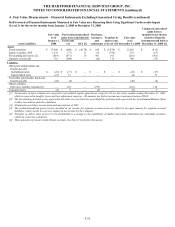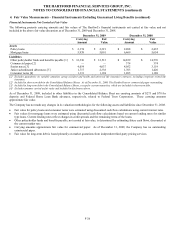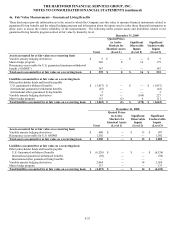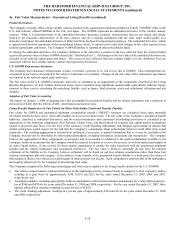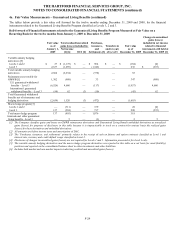The Hartford 2009 Annual Report Download - page 168
Download and view the complete annual report
Please find page 168 of the 2009 The Hartford annual report below. You can navigate through the pages in the report by either clicking on the pages listed below, or by using the keyword search tool below to find specific information within the annual report.THE HARTFORD FINANCIAL SERVICES GROUP, INC.
NOTES TO CONSOLIDATED FINANCIAL STATEMENTS (continued)
F-19
4. Fair Value Measurements – Financial Instruments Excluding Guaranteed Living Benefits
The following financial instruments are carried at fair value in the Company’ s Consolidated Financial Statements: fixed maturities and
equity securities, available-for-sale (“AFS”), equity securities, trading, short-term investments, freestanding and embedded derivatives,
and separate account assets.
The following section and Note 4a apply the fair value hierarchy and disclosure requirements for the Company’ s financial instruments
that are carried at fair value. The fair value hierarchy prioritizes the inputs in the valuation techniques used to measure fair value into
three broad Levels (Level 1, 2 or 3).
Level 1 Observable inputs that reflect quoted prices for identical assets or liabilities in active markets that the Company has the
ability to access at the measurement date. Level 1 securities include highly liquid U.S. Treasuries, money market funds and
exchange traded equity, open-ended mutual funds reported in separate account assets and derivative securities, including
futures and certain option contracts.
Level 2 Observable inputs, other than quoted prices included in Level 1, for the asset or liability or prices for similar assets and
liabilities. Most debt securities and preferred stocks, including those reported in separate account assets, are model priced by
vendors using observable inputs and are classified within Level 2. Also included in the Level 2 category are derivative
instruments that are priced using models with significant observable market inputs, including interest rate, foreign currency
and certain credit default swap contracts and have no significant unobservable market inputs.
Level 3 Valuations that are derived from techniques in which one or more of the significant inputs are unobservable (including
assumptions about risk). Level 3 securities include less liquid securities such as highly structured and/or lower quality asset-
backed securities (“ABS”), commercial mortgage-backed securities (“CMBS”), commercial real estate (“CRE”)
collateralized debt obligations (“CDOs”), residential mortgage-backed securities (“RMBS”) primarily backed by below-
prime loans, and private placement securities. Also included in Level 3 are guaranteed product embedded and reinsurance
derivatives and other complex derivatives securities, including customized GMWB hedging derivative (see Note 4a for
further information of GMWB product related financial instruments), equity derivatives, long dated derivatives, swaps with
optionality and certain complex credit derivatives are also included in Level 3. Because Level 3 fair values, by their nature,
contain unobservable market inputs as there is little or no observable market for these assets and liabilities, considerable
judgment is used to determine the Level 3 fair values. Level 3 fair values represent the Company’ s best estimate of an
amount that could be realized in a current market exchange absent actual market exchanges.
In many situations, inputs used to measure the fair value of an asset or liability position may fall into different levels of the fair value
hierarchy. In these situations, the Company will determine the level in which the fair value falls based upon the lowest level input that
is significant to the determination of the fair value. In most cases, both observable (e.g., changes in interest rates) and unobservable
(e.g., changes in risk assumptions) inputs are used in the determination of fair values that the Company has classified within Level 3.
Consequently, these values and the related gains and losses are based upon both observable and unobservable inputs. The Company’ s
fixed maturities included in Level 3 are classified as such as they are primarily priced by independent brokers and/or within illiquid
markets (i.e., below prime RMBS).











